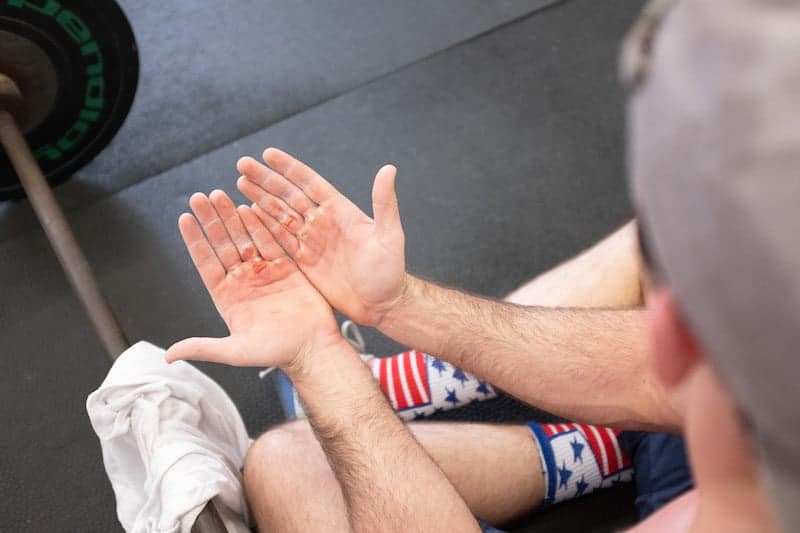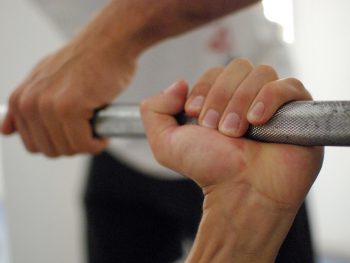
Ripped hands in CrossFit are no fun. Typically within the first month or two of starting a functional fitness routine, you’ll have questions about your hands. Why are they so tender? Why are they callusing? What can you do to treat them and make them better?
Yes, if you’re working on gymnastics movements, you can use grips! (Find our favorite grip recommendations here.)
But for some movements, sometimes grips just don’t work. When you’re working with a barbell, kettlebell, or dumbbell and moving quickly, often grips are more of a hinderance than help.
Can’t I just wear gloves?
Technically, yes, you can. However, we don’t recommend gloves for a couple of reasons.
First, gloves are going to make it harder to keep a good grip on whatever you’re holding. While they often have rubber or a synthetic gripping material on the palm, they aren’t really designed for the fast-paced movements of functional fitness training or CrossFit.
Second, they will keep you from building calluses, but they won’t necessarily protect your hands in the way you want them to. You’ll get sweat build up inside the glove, which will trap the moisture, and your skin might peel or tear anyway because of it.
Essentially, you’ll get the opposite of no glove – the skin will be TOO soft, and won’t be able to withstand the work you are asking of it.
So, when you’re working on dynamic movements that are not gymnastics related, we recommend skipping the grips and the gloves. Being able to FEEL the object and what you’re doing is key.
This does require a bit of preventative maintenance and care, which is what we’re going to talk about here!
Occasionally, you’ll encounter people who show off their ripped hands in CrossFit with pride. Do not be this person.
All this shows is that they do not know how to do proper hand maintenance in order to prevent tears from happening, and they don’t treat them properly once they’ve already torn.
No more ripped hands in CrossFit! Here’s how to treat current rips and prevent future rips, in four easy steps.
Step 1: Smooth those puppies down.
There are several awesome tools out there for this, but a great one is the PedEgg. A PedEgg was designed to smooth down the rough spots on your feet, so it was basically invented for this purpose – we’re just going to use it on our hands. One part of it has this metal screen that looks a bit like a cheese grater, and the other side has an emery board surface.

Just after showering, use the grating side first to rough off any extra dead skin, and then use the emery board as a shaping tool. You goal is a long, smooth callus without ridges, especially around your finger joints.
There are a few other methods you can use here as well. Some people like to use a regular nail file, some scrape with a razor blade (CAREFULLY!), and I personally also occasionally trim the top layer of dead skin off with a cuticle clipper, then trim carefully around the edges to make sure they aren’t jagged.
Remember, you’re not looking to remove the callus – you need it to help protect your hands in the next workout! You’re just looking to smooth the extra, rough dead skin off.
Step 2: Moisturize.

Find a good moisturizer to keep your hands supple. Something like Lucas Pawpaw Ointment, Bag Balm, or Neutrogena works best.
Apply after Step 1, but also regularly when your hands are feeling dry. Dry skin = cracked skin, which leads to tears!
Step 3: Avoid excessive chalking.

Chalk should be used to dry the hands in a workout, not to turn your hand into something resembling the white glove that Michael Jackson used to wear.
Try alternating chalk with toweling your hands dry to reduce the drying effect that chalk has on your skin.
If your hands become too dry, the skin could crack and then you have a whole other problem.
After you finish your workout, wash your hands to remove any extra chalk. If you leave the chalk on for a long time, it continues to absorb moisture that your skin is producing, which can lead to…you guessed it, dry and cracked skin.
If you have some moisturizer in your gym bag, slap a little of that on too. If not, that’s ok – just make sure to put it on after you shower.
Step 4: Learn the best way to grip.
Whether its the rig, a barbell, a kettlebell, or something else, knowing the right way (and using it!) is essential to keeping your hands in good working order.
This method will take time to strengthen, but will save your hands in the long run. Personally, it took me a couple of weeks to get used to it, but then it became normal and I’ve been using it ever since.

When appropriate, grip the implement primarily in the first knuckle of your fingers (as indicated by the red arrow in the picture below), and not in the middle of your palm.
If you grip the bar in the middle of your palm, it will essentially squish the calluses of your upper palm, stretching them out and causing them to tear, but if you grip in the first joint of your fingers, that pressure goes away.
Once you have calluses built up in this area, it helps. They act as a bit of an indicator of where to grip. If you’re having pain when gripping, or the middle of your palm feels both sweaty and tender, reset your grip.
What if you DO tear?
Sometimes, regardless of all our efforts, our hands tear. If your hands tear during a workout – STOP doing the movement that caused them to tear.
The beauty of functional fitness and CrossFit is that it is infinitely scalable, and there are any number of reasons to scale.
Hands tear on pullups? Switch to ring rows. Don’t have rings? Switch to a standing DB or KB row.
If you’re bleeding – do not “push through.” There will always be another workout. If you do damage to your hands today, it means you won’t be able to work out tomorrow.
Tend to them right then and there, get them clean, get them trimmed, and allow them air to heal.
If you’re going to shower, be forewarned that the water will STING on these types of tears. You can place a thin layer of Vaseline, Aquaphor, or other petroleum based water resistant coating on them to keep the water out for the first shower or two. After about 24 hours, they should have healed enough to be able to withstand water on them.
Remember: ripped hands in CrossFit are not a trophy or something to be proud of. They just tell people that you don’t necessarily know the best way to care for your hands, and that you’re too stubborn to listen to your body when it’s telling you something.
Do the maintenance work to prevent tears, and if one does occur, take care of it to help it heal as quickly as possible, so you can get right back to your training routine.












